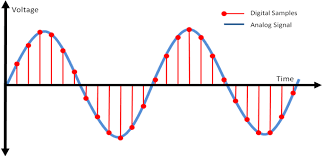Analogue to Digital Conversion

© copyright aivpcoreyless.blogspot.co.uk
Good site for details of how GSM works.
When a phone call is made the task is to convert the analogue input (talking) to a digital representation of the wave. With the ability to reverse this step to allow the phone call to be heard. In the process there is a need to maintain the quality of the speech but limiting the data generated. This is a regular requirement in electronics and A-D conversion is standard and carried out in hardware thus fast transformation
The basic process is to sample the wave at a fixed rate, recording the height of the wave at this time. Standard sampling rate is 8kHz sampled at 256 levels (8 bits). This gives a rate of 64kbps which is a high level. The image shows how thi sampling works.
Given that the input wave is continuous, there are no discontinuities, even a slow sample rate of 8kHz will show only small changes in amplitude between sample points. Thus the change rather than the absolute value can be recorded. This reduces the amount of data that needs to be transmitted. The data reduction technique is RPE-LTP, Regular Pulse Excited - Long Term Prediction. The speech is split into 20ms blocks of 260 bits giving a rate of 13khz.
*u* ©mobilephonetechnology.co.uk all rights reserved 2017- 2025



